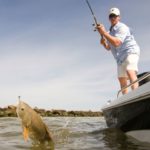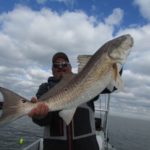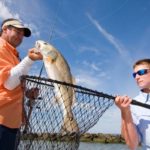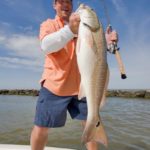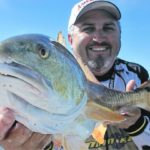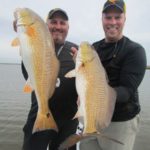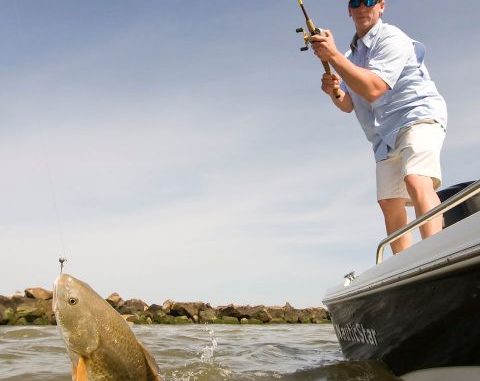
Head to the Cameron jetties to find all the right conditions to result in easy limits of redfish. Here’s how this guide catches them on the rocks.
Redfish have an uncontrollable hunger.
Rocks harbor an unending buffet of bait.
I’m not much of a rocket scientist, but it seems to me anybody looking to catch a redfish ought to consider fishing rocks.
But I probably wouldn’t waste a lot of time fishing one rock, a couple rocks or even a pile of rocks.
If I’m looking for a limitless supply of hungry redfish, I’m going to target a line of rocks.
For much of Louisiana, lines of rocks are typically found at the jetties that jut out from rivers, bayous and canals into outer bays or even the Gulf of Mexico itself.
Some jetties, like the MRGO rocks, go on for miles.
Others jetties, like the Caminada Pass jetties at Grand Isle, are hardly much more than a long cast from shore.
Still, regardless of the length of Louisiana’s rock jetties, there are no better places to find feeding redfish than at these lines of rocks.
One of the most-popular and heavily fished set of jetties in all of the state are the Cameron jetties extending into the Gulf of Mexico below the Calcasieu Ship Channel.
This twin line of rocks that stretches about a mile out from the coast not only serves as a buffet table for redfish, but it also is the beginning — or ending — of a highway that redfish moving from the Gulf of Mexico to Calcasieu Lake follow.
Like pulling off I-10 to get your popcorn shrimp at Popeye’s, traveling redfish can’t help but take advantage of such a convenient location to stop and get something to eat before getting back on the road.
If fishing a line of rocks doesn’t excite you all that much, you should try to track down Cajun Phil Broussard, who guides on Calcasieu Lake with Kevin Broussard (337-274-0788), next time you see him at a fishing show and get him to start talking about fishing the Cameron jetties.
His excitement about fishing the Cameron jetties — in fact any set of jetties — is infectious enough to make you want to see for yourself what all the fuss is about.
“If Kevin (Cajun Phil’s son and redfish tournament partner) and I are in a tournament, you can bet we’re going to be taking a look at whatever jetties are nearby,” Broussard said. “And given the right conditions, we can smoke the redfish wherever we are.”
Although Broussard has fished jetties from Florida to Texas, he understands there is something a little extra special about the Cameron rocks.
“First off, they’re long,” he said. “A lot of the jetties we see during tournaments are short. And the Cameron jetties have lots of loose spots where water comes through the rocks from one side of the jetty to the other; a lot of other jetties we fish are so tightly packed that no water can get through.”
Because of those two reasons, coupled with the fact that every redfish that moves from the Gulf of Mexico to Calcasieu Lake has to pass this stretch, Broussard ranked the Cameron jetties as good as any he’s ever fished.
As good as the Cameron jetties can be, however, making the decision to fish them isn’t as simple as it might sound.
“We like to give our customers what they want, so we ask them do they want to do it big or small,” Broussard said. “If they’re willing to go out and do battle, we head to the jetties and usually hammer plenty of good ones.”
But, even then, Broussard said he can’t just carry his customers down to the jetties without paying attention to the details that can turn them completely on or completely off.
“The entire key to hammering redfish on the jetties is tide,” Broussard explained. “Clear water is best, but we still catch in muddy water.
“But turn that tide off, and we might catch one or two. Turn it on, and we catch boat loads of reds.”
Another detail Broussard monitors is wind direction, because an east wind brings lots of pretty, clear water in from the Gulf of Mexico — especially during an incoming tide — whereas a west wind brings in muddy water from the beaches to the west of the jetties.
“Give me a good incoming tide with an east or south wind, and I’ll be happy at the jetties,” Broussard said. “You can still catch them on a falling tide, but the water isn’t nearly as pretty.”
Not only is the tide instrumental in how good the Cameron jetty redfish bite is, but the tide dictates how redfish set up along the rocks and how Broussard fishes them.
“The first thing you’ve got to understand about fishing these jetties is that there are several places along the rock wall where boulders have fallen away and sit at the bottom just off the main line,” Broussard said. “And there are a few places along the jetties that have some oyster reefs right off the rocks.”
According to Broussard, redfish use the tide to their advantage by getting in the downcurrent side of separated boulders and oyster reefs, where they watch for baitfish passing overhead.
“That’s why we always position our boat so we can cast into the current,” Broussard said. “This way, we can work our baits back in the most natural way possible. And when one of our baits pass over their heads — BOOM — they’ll run up there and grab it.”
But getting a bait to the bottom can be an exercise in frustration. If you’ve got a screaming tide, Broussard said you can’t have enough weight to get to the bottom without going to extremes.
“We’ve been out there hammering them in a strong tide while everybody else around us was struggling,” Broussard said. “The only difference was that we were using ¾- and 1-ounce weights while they were using ½-ounce or lighter.”
Too light of a weight in such fast current means your bait isn’t getting anywhere near the fish. In Broussard’s estimation, a bait with a ½-ounce weight might pass 10 feet over the bottom so fast that no redfish will even see it much less bite it.
Broussard said he and Kevin can generally catch redfish on plastics just about any time they go as long as they play the tide right; however, he acknowledged that now would be a good time to throw live pogies or live mullet.
“Or you could do like ol’ Bill Lake does over at Bayou Dularge and stop to buy a dozen crabs off a boat,” Broussard advised. “Break them in half and then in half again to get four pieces — that’s a no-brainer on the jetties.
“They won’t last long, I guarantee you.”
Getting these baits to the fish doesn’t seem all that complicated; however, Broussard said the key to staying on the bite is deciding between fishihg a jighead or a Carolina rig.
“It all depends on how thick the rocks are,” he said. “If there are a lot or rocks on bottom, we generally do better with the jigheads. But if the bottom is clear enough, we’ll throw the Carolina rig with the weight about 18 inches ahead of the bait. That weight will kick up a little commotion on bottom that makes redfish come investigate.”
As for artificial lures, Team Broussard catches their fair share of redfish on soft plastics fished on jigheads, but one of their favorite ways to fish the Cameron jetties is with modified spinnerbaits.
“We do catch a lot on spinnerbaits,” Broussard said. “People don’t throw them down there because they can’t keep them near the bottom. We add a heavy sliding weight on our line before tying on a spinnerbait.
“Redfish will tear them up, though, so you better have a wad of spinnerbaits in your boat.”
Down at the jetties, anglers can expect to catch redfish anywhere from rat status up to 40 pounds. And the fun part, according to Broussard, is that with so many giant redfish on the rocks he and his customers typically have to catch 20 to get their five keepers.
And in that deep water the fish put up quite the battle.
“They’ll run deep and pull line off like crazy,” Broussard said. “We’ve been spooled a few times ourselves because they fight so much harder in deep water. We can whip them pretty quick in shallow water because they can’t go down.
“Because it’s such a battle around all those rocks, we don’t use monofilament at all and stick with at least 40-pound FINS braided line.”
The key to catching just about any saltwater fish is to find where fish, bait and current collide.
Arguably, there is no better spot in all of coastal Louisiana to find a better collision than the Cameron jetties.
Set your course for them this summer, and you’re sure to run into a fight.
